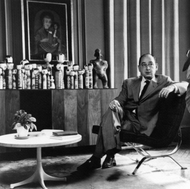Designer Spotlight: George Nelson
Posted by Harvey Schwartz on Jan 29th 2020
One designer who has been extremely prolific is Charles and Ray Eames’ friend and fellow designer for Herman Miller, George Nelson. Nelson has either initiated or perfected many innovations which have profoundly affected the organization of the modern house. In his storage wall – an idea he has continued to explore for new variations since the late 1940s – he devised an ingenious system of shelves and supports that could be assembled to accommodate in one out-of-the-way wall all manner of equipment including bar, television, hi-fi and desk, as well as storage space. He was also one of the originators of the now ubiquitous modular system of furniture, in which seating, cabinets, tables and desks are composed of interchangeable parts, adaptable to any new use or whim. An architect as well as a furniture designer, Nelson has always attempted to integrate furniture with architecture to achieve greater space, utility and harmony; and most of his designs for free-standing pieces, such as sofas and armchairs, like his storage walls and modular systems, are simple geometric shapes, usually with raised “platform” seats, to harmonize with the straight lines of the modern house and to preserve its open expanses.
Nelson merrily strayed from his geometric bent with what may appropriately be called a delicious 1956 collection of seating including confections like the marshmallow sofa which plumped people down on an array of individual foam rubber “marshmallows” and a hard-shelled, triangular number called the coconut chair. Impertinent commodities like these, combined with broad curiosity about everything from abstract ideas to semi-abstract clocks (he designed the screen titles for The Misfits and concocted a Camera Three television program called How to Kill People: A Problem in Design), and a critical intelligence that weaves the most irreconcilable contradictions into lucid human organization, has prompted one critic to call Nelson “his own best design.” Sociable, articulate and witty to boot, he is in much demand as a speaker and writer.
The kind of modern house for which Nelson planned his near, geometric furniture – a house with open spaces, overlapping volumes, indoor-outdoor flow, and everything possible built in – placed the chair in the limelight. There it stands, in splendid isolation, the most conspicuous piece of furniture in the room.

